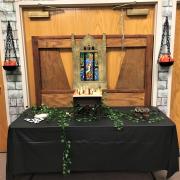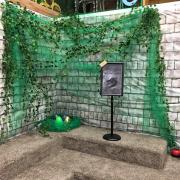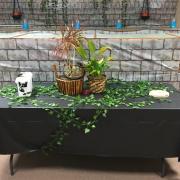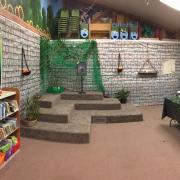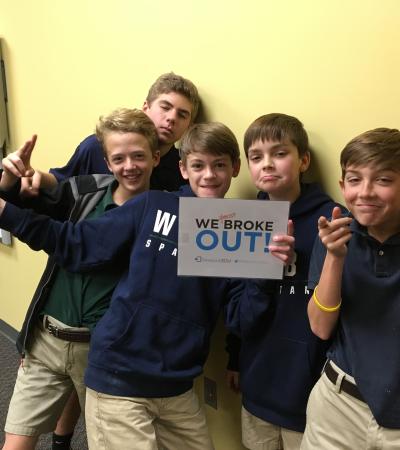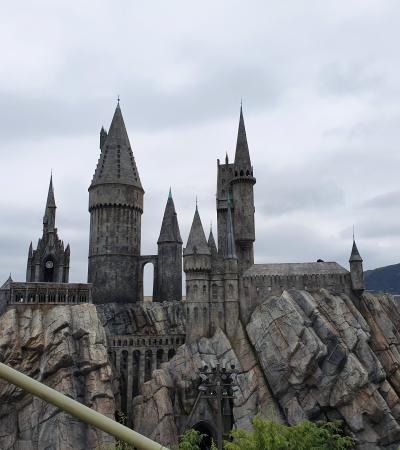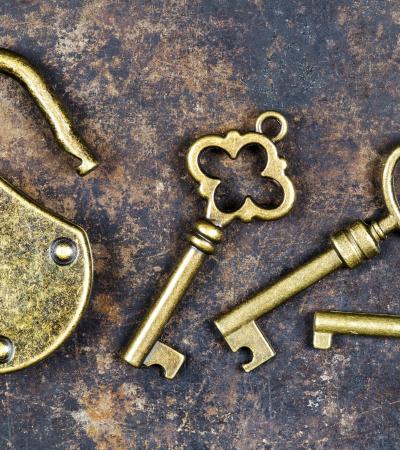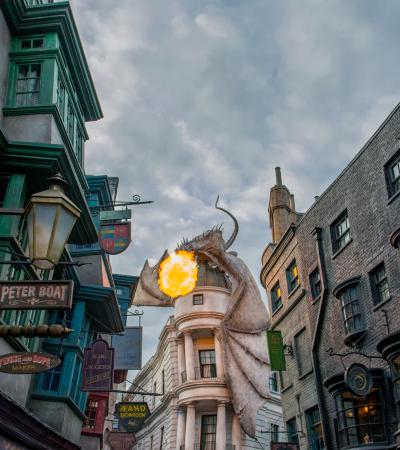Duchesne County Library Roosevelt Branch Library's fantasy role-playing game is a new twist on the traditional escape room. Participants assume a role with specific strengths and weaknesses that dictate who can complete which task.
The guild must complete a series of puzzles and find an artifact before time runs out, making sure not to lose all their lives along the way.
Advanced Planning
Two librarians started planning this escape room in January 2020. We had done two different escape rooms in the past with a lot of success. Please see the attachments on the right side of this page for details on our planning process.
Due to the demand and popularity of this type of event, we challenged ourselves to come up with something new. We sought to further our participants’ teamwork and problem-solving skills by turning it into a role-playing game.
Our trial runs before the event helped us weed out a lot of confusion regarding players’ strengths and weaknesses and unnecessary length in the game.
Marketing
We created an event on Facebook, linking our patrons to Eventbrite, where they were able to sign up for a time slot. We also included the event in our monthly newsletter.
In the past we had made tickets available too early, causing some of our patrons to forget about the event. This time we made tickets available on July 6, allowing patrons about a week and a half to reserve their time. However, with the pandemic affecting us, our sessions did not fill up as fast as they normally do. We ended up having one unfilled session by the time the event began.
It was still successful, but we did not get the typical response we were used to.
Budgeting
We spent roughly $280 on this event. We spent a lot of time shopping around for different escape room props, but after seeing high prices for potentially unreliable items, we decided to create some of our own. We were fortunate enough to have a lot of supplies on hand, like wood, paint and a wood burner, to make our own props.
Other items were investments from our previous escape rooms that we have been able to reuse for our events. We were also fortunate enough to have access to a 3D printer at our parent branch so we could print and paint props found on Thingiverse for free.
Repurposing discarded library books and using items from your home and your coworkers’ homes (if they are willing) are effective ways to save some money. Other items we were able to purchase from Amazon and local stores for a reasonable price.
Day-of-event Activity
The two librarians in charge of the event set up the escape room. Since we do not have a community room at our library, we have to take over our children’s room for these events. As such, we had to wait until the library was closed before setting up.
Because we anticipated a long set-up and sessions began at 10 a.m., we decided to do it the night before. It took around 3.5 hours to get the room ready (much of this time was spent hanging our dungeon wallpaper).
We needed three people to run this event. We had two people (the librarians in charge and familiar with the escape room) in the room with our patrons to provide any help needed and to prevent any damage to our props/room. The third person was at our circulation desk, checking in participants as they arrived. Each 45-minute session proceeded smoothly.
Program Execution
The program was held over two days with six sessions per day (one session never filled, and we had one last-minute cancellation, so we had 10 sessions total). Each session could contain a five person maximum. We had 50 people participate total.
When a session began, we let our participants choose an avatar (paladin, wizard, bard, druid or rogue). Each character had a labeled bag with special items and character stats. The paladin possessed the scroll with the instructions and first clue to get them started. At one point in the room, the guild has a choice to follow one of two paths: the longer, easier path where they could use cheats or the shorter, more difficult path where they had to forfeit their remaining cheats. Most participants chose the longer and easier path.
Because this escape room was a little more challenging, three of our ten groups ran out of time before they were able to obtain the artifact. Our escape room definitely got our participants thinking before acting and using teamwork to solve the room. Most of our participants expressed positive opinions after their session, and one group was kind enough to leave us a glowing Google review.
Advice
One of the problems that became apparent when we held our sessions was our duplicate locks. We had five lockboxes in the room with a directional lock, a word lock, a padlock and two number locks. One number lock corresponded to one path, the other to another path. We did not label these locks in any way, so there was some confusion when a group had to unscramble a combination and did not know what lock to use. We recommend color-coding any duplicate locks or letting your participants know which box is correct.
Also, with our pH indicator potions, we highly recommend filling your goblets full of the indicator and adding the acid/base to the indicator to the get the pigment needed. There are a lot of moving parts and details to this escape room, so allow yourself plenty of time to set up the room.
We also recommend laminating paper clues as much as possible and sealing wood, etc. so you can disinfect everything between sessions.
We had everyone that came into the room use hand sanitizer before handling anything.
As with any escape room, make sure to schedule trial runs before the event so you can work out any problems with the room.
Supporting Materials
- Feedback (Coming Soon!)
- Programming Librarian Facebook Group

